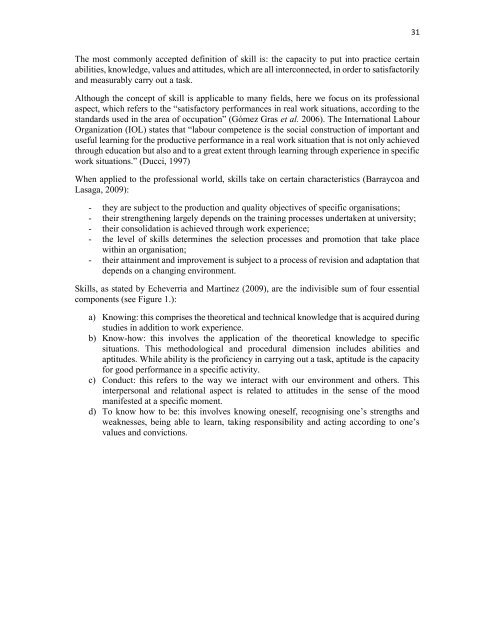and Music
Omega-Book
Omega-Book
You also want an ePaper? Increase the reach of your titles
YUMPU automatically turns print PDFs into web optimized ePapers that Google loves.
31<br />
The most commonly accepted definition of skill is: the capacity to put into practice certain<br />
abilities, knowledge, values <strong>and</strong> attitudes, which are all interconnected, in order to satisfactorily<br />
<strong>and</strong> measurably carry out a task.<br />
Although the concept of skill is applicable to many fields, here we focus on its professional<br />
aspect, which refers to the “satisfactory performances in real work situations, according to the<br />
st<strong>and</strong>ards used in the area of occupation” (Gómez Gras et al. 2006). The International Labour<br />
Organization (IOL) states that “labour competence is the social construction of important <strong>and</strong><br />
useful learning for the productive performance in a real work situation that is not only achieved<br />
through education but also <strong>and</strong> to a great extent through learning through experience in specific<br />
work situations.” (Ducci, 1997)<br />
When applied to the professional world, skills take on certain characteristics (Barraycoa <strong>and</strong><br />
Lasaga, 2009):<br />
- they are subject to the production <strong>and</strong> quality objectives of specific organisations;<br />
- their strengthening largely depends on the training processes undertaken at university;<br />
- their consolidation is achieved through work experience;<br />
- the level of skills determines the selection processes <strong>and</strong> promotion that take place<br />
within an organisation;<br />
- their attainment <strong>and</strong> improvement is subject to a process of revision <strong>and</strong> adaptation that<br />
depends on a changing environment.<br />
Skills, as stated by Echeverria <strong>and</strong> Martínez (2009), are the indivisible sum of four essential<br />
components (see Figure 1.):<br />
a) Knowing: this comprises the theoretical <strong>and</strong> technical knowledge that is acquired during<br />
studies in addition to work experience.<br />
b) Know-how: this involves the application of the theoretical knowledge to specific<br />
situations. This methodological <strong>and</strong> procedural dimension includes abilities <strong>and</strong><br />
aptitudes. While ability is the proficiency in carrying out a task, aptitude is the capacity<br />
for good performance in a specific activity.<br />
c) Conduct: this refers to the way we interact with our environment <strong>and</strong> others. This<br />
interpersonal <strong>and</strong> relational aspect is related to attitudes in the sense of the mood<br />
manifested at a specific moment.<br />
d) To know how to be: this involves knowing oneself, recognising one’s strengths <strong>and</strong><br />
weaknesses, being able to learn, taking responsibility <strong>and</strong> acting according to one’s<br />
values <strong>and</strong> convictions.


